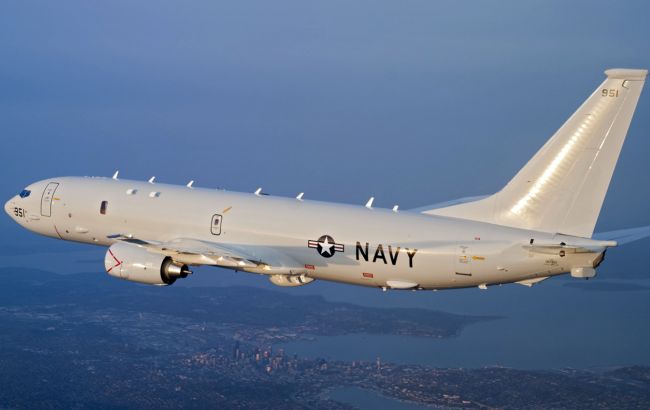
U.S. Military planes made flights near Crimea
Patrol anti-ship plane of U. S. army 09-24-2016 had flew up to Crimea's border. About this witnessed data of many western websites which kept a wary eye on motion of military aviation, says Interfax.

Tank warfare is periodically declared obsolete in the face of the latest portable anti-tank weapons and the difficulty of transporting heavy vehicles to the battlefront. Just don’t tell that to Ukraine.
The intervention of Russian tanks in August 2014 into Kiev’s conflict with separatists in Eastern Ukraine reversed what was looking like an eventual government victory into a disastrous route. In January 2015, an assault by over 30 Russian tanks defeated defending Ukrainian armor and brought an end to the months-long siege of Donetsk International Airport.
Kiev primarily fielded locally manufactured T-64 tanks in the conflict. These were considered “super tanks” during the Cold War…fifty-five years ago. Confronted by IEDs, modern anti-tank missiles and Russian tanks of equal or superior quality (including upgraded T-72s), they suffered heavy losses. The Ukrainian Ground Forces lost over 200 T-64s—possibly many more—in the conflict, which remains unresolved to this day.
Ukraine, however, has already developed a very modern tank, the T-84 Oplot (Bulwark)-M. Only ten Oplot tanks are in service with the Ukrainian Army, but Malyashev factory in Kharkiv announced in 2015 that it was ramping up production. By 2017, the factory will have produced forty new Oplots…and will be sending them to Thailand.
What’s special about the Oplot?
The T-84 Oplot is basically a Ukrainian-made derivative of the speedy T-80 tank—once considered the pinnacle of Soviet-era tank design. The T-80 never got over the bad rap it received in the first Chechen War when hundreds were knocked out by Chechen rockets. This was largely a result of terrible tactics—the tanks, manned by untrained conscripts, were sent into the middle of the city of Grozny without much infantry support. However, the T-80s’ gas-guzzling engines and tendency of their ammunition to catch fire when the tank was hit was seized upon for official blame, and led to Russia withdrawing this type from use in favor of cheaper, upgraded T-72 tanks, and later, T-90s.
Ukraine, seeking to develop its arms industry independently from Russia after splitting from the Soviet Union, designed a souped-up T-80 with a more powerful engine and a new turret called the T-84. Several T-84 variants were conceived, culminating in the T-84 Oplot-M, which features a Western-style turret mounting the latest Ukrainian sensors and defensive systems.
The Oplot-M is agile, has excellent sensors, and is well protected by active and passive defensive systems. Most notably, it offers these niceties at a price of $5 million dollars at a time when contemporary main battle tanks like the LeClerc and upgraded M1s are clocking in at $8 million.
How Does the Oplot Compare to Russia’s T-90 Main Battle Tanks?
The Oplot may find a counterpart in the Russian T-90, itself an evolution of the T-72 tank. The T-90 is Russia’ s current top-line tank while it awaits its innovative new T-14 Armatas to enter service. It has also been exported widely, notably to India. Unlike the T-72, which makes up the majority of the Russian tank fleet today, the T-90 doesn’t appear to have been deployed in support of the separatists in Eastern Ukraine. (For the purposes of this comparison, the T-90A in frontline Russian service will be compared, rather than the superior T-90AM, which appears to have been passed over for large scale production in favor of the T-14 Armata.)
Both tanks have three-man crews, but the 5-ton Oplot-M is larger at 2.8 meters in height, while the 46-ton T-90 keeps a lower profile at 2.2 meters.
The Oplot-M and T-90 use similar 125 millimeter guns relying on automatic loaders. The 2A46 gun on the T-90 proved incapable of penetrating the frontal armor of U.S. Abrams tanks during the 1991 Gulf War, but later types of Russian tungsten and depleted uranium ammunition have reportedly improved penetration by as much as 50 percent to the equivalent of around 650 millimeters of Rolled Harden Armor. That’s just barely enough to penetrate the frontal armor of modern Western tanks at shorter combat ranges. However, Ukrainian access to modern ammunition is not a given.
Both vehicles can also launch anti-tank missiles through the gun tube for use against low-flying helicopters or targets at very long ranges where the main gun won’t serve, and pack 12.7 millimeter and 7.62-millimeter machine guns as secondary weapons.
Later models of the T-90 use French-licensed Catherine thermal sights, while the Oplot relies on a domestically produced PNT-2 system, supplemented by a massive PNKS-6 panoramic site over the turret. Tank battles are usually won by the side that spots and hits first, so sights and sensors are an important factor in armored warfare-but comparing their relative effectiveness can be difficult.
In terms of protection, the T-90’s composite armor is rated equivalent to around 600 millimeter RHA verses tank sabot rounds, and over 800 for the shaped charges used in missiles. Figures for the Oplot, on the other hand are difficult to find, though given its weight, the protection level is likely at least comparable. In any case, in practice both vehicles rely on explosive-reactive armor and both passive and active countermeasure systems to significantly enhance survivability.
 Philippines Foreign Minister Perfecto Yasay told the United
Nations on Saturday his country's new president, Rodrigo Duterte, had an
"unprecedented" mandate and the world should not interfere in his
crackdown on crime. Addressing the annual U.N. General Assembly, Yasay
said the Duterte government was "determined to free the Philippines from
corrupt and other stagnating practices, including the manufacture,
distribution and use of illicit drugs. Our actions, however, have
grabbed both the national headlines and international attention for all
the wrong reasons," he said. "We urge everyone to allow us to deal with
our domestic challenges in order to achieve our national goals without
undue interference." ...
Philippines Foreign Minister Perfecto Yasay told the United
Nations on Saturday his country's new president, Rodrigo Duterte, had an
"unprecedented" mandate and the world should not interfere in his
crackdown on crime. Addressing the annual U.N. General Assembly, Yasay
said the Duterte government was "determined to free the Philippines from
corrupt and other stagnating practices, including the manufacture,
distribution and use of illicit drugs. Our actions, however, have
grabbed both the national headlines and international attention for all
the wrong reasons," he said. "We urge everyone to allow us to deal with
our domestic challenges in order to achieve our national goals without
undue interference." ...
 The Air Force F-35A Lightning II, assigned to the 56th Fighter
Wing, experienced what the service said was a “ground emergency” at
about 12:20 p.m. eastern Friday at the base, according to a statement.
Seven of the stealthy fifth-generation fighters have been at Mountain
Home since Sept. 10 to use the base’s range for surface-to-air training,
the statement said. The Air Force said the cause of fire is under
investigation. Last week, the Air Force ordered a temporary stand-down
of 13 out of 104 F-35s in the fleet “due to the discovery of peeling and
crumbling insulation in avionics cooling lines inside the fuel tanks,”
according to a statement at the time. Two additional aircraft, belonging
to ...
The Air Force F-35A Lightning II, assigned to the 56th Fighter
Wing, experienced what the service said was a “ground emergency” at
about 12:20 p.m. eastern Friday at the base, according to a statement.
Seven of the stealthy fifth-generation fighters have been at Mountain
Home since Sept. 10 to use the base’s range for surface-to-air training,
the statement said. The Air Force said the cause of fire is under
investigation. Last week, the Air Force ordered a temporary stand-down
of 13 out of 104 F-35s in the fleet “due to the discovery of peeling and
crumbling insulation in avionics cooling lines inside the fuel tanks,”
according to a statement at the time. Two additional aircraft, belonging
to ...

The Chinese economic slowdown comes as no surprise to global analysts. As outlooks are adjusted accordingly, it isn't the country's profit margins that are causing concern, but the decades of spending on unfinished building projects that have created a deluge of bad debt for China.
Taxpayers point the finger of blame at the government and the lack of social change and development evaluations before money is squandered on the hundreds of unfinished projects, or "rotten buildings" as they have come to be known.
|
Even with the general jitters, this kind of transmission can have an impact on all economies that export to China. |
According to the Chinese government, China currently has two billion square metres of empty residential space - enough to house 100 million people.
Economists echo the peoples' sentiments with the reason for a potential crash placed squarely on the government's shoulders with its insatiable desire for hyper growth. As a result, a debt crisis is a serious possibility.
But many continue to deny China's seemingly inevitable forecast, including the Chinese premier, Li Keqiang.
"We are fully confident of China's long-term economic growth. As long as we continue to reform and open up, China's economy will not suffer a hard landing," said Keqiang.
Critics, however, remain doubtful - the endless sea of deserted developments standing as evidence of their fears for the future.
"The economy is not getting better; I see that now. The factories are no longer thriving, and salaries have not gone up with our nation's development. It has all changed. How did it come to this? It's terrible," laments former factory worker Meng Shi Jun.
With China adamant that there are no real risks in its future, what can the global economy expect? Will there be ongoing, or even increasing, debt and banking problems?
"China is, by some measures, the biggest economy in the world, and it is very well integrated into the global supply chain - anything that happens in China will have repercussions globally," says Sebastien Marlier of the Economist Intelligence Unit.
Gender equality is a UN sustainable development goal that continues to appear out of reach as the gender pay gap continues to exist in workplaces around the world.
The World Economic Forum has forecast that it will be another 118 years before pay parity is achieved.
Higher positions of management are also part of this inequality scale.
The London Stock Exchange currently only affords seven out of every 100 women a managerial position.
Also in the UK, the pay gap stands at 18 percent between men and women, deepening even further after childbirth.
We speak to Robert Joyce from the Institute for Fiscal Studies about what is causing the gap and what can be done to speed up measures of equality. We also speak with Catherine Hill, director of research at the American Association of University Women about the deniers of gender pay inequality.
Patrol anti-ship plane of U. S. army 09-24-2016 had flew up to Crimea's border. About this witnessed data of many western websites which kept a wary eye on motion of military aviation, says Interfax.

It was pointed out that the plane P-8A Poseidon with number 168 855, taken off from avia-base Sigonella on Cecilia in afternoon had made reconnaissance flights over Black Sea equator on North Western direction of sea shore of Crimea.
It was also informed that on September